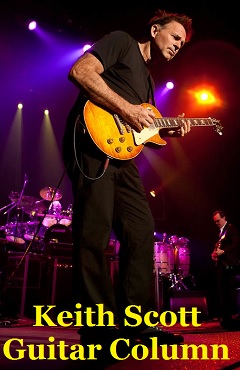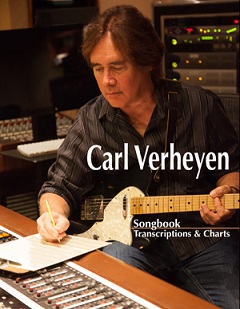Daytona
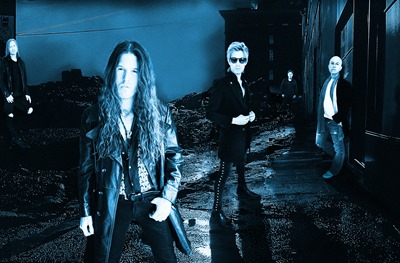
When we think of catchy and melodic ’80s-style arena rock, those who experienced it in real time can instantly picture the songs and sounds that defined the era. Swedish band DAYTONA has recreated that very image with their debut album, Garder La Flamme, delivering the sound, music, and even music videos that embody the spirit of the time. Their music not only meets the expectations of those who lived through the era, but also feels nostalgic yet refreshingly new at the same time. We spoke with Erik Heikne (guitar) and Fredrik Werner (vocals), who took the lead in songwriting for the album, about their work and inspirations.
Interview / Text Mamoru Moriyama
Translation Hiroshi Takakura
Muse On Muse : For those encountering you for the first time through this interview, could you share your profile and tell us about your music career so far?
Erik Heikne : I’m primarily a guitarist, but also a producer and songwriter. When I first started with bands, we were into heavy metal, but around the age of 20, I began discovering AOR and classic rock, and that’s when I decided to start a new band. That became Miss Behaviour, and we had a fairly successful run with four albums and tours across Europe. I’ve also written songs for others and contributed to various albums, but now my full focus is on Daytona.
Fredrik Werner : Where should I begin! I guess we can start with my long tenure as vocalist with Osukaru, which has been going strong for over ten years now. It was my first venture into the realm of melodic rock when I took over vocals and lead guitar back in 2013, I think. Though it was a bit later that the band really solidified its style into what you hear today. We like to call it glam metal now—a 2024 reincarnation of that 80s hair metal style, if it were invented today. The best way to experience Osukaru is by listening to our latest release, Starbound.
A few years later, I was contacted by Air Raid, a well-known Gothenburg band in the heavy metal scene. This was a style I really enjoyed and one that definitely suited my voice, as the group was moving toward a more melodic approach to their traditional heavy metal. We hit it off well, and I’ve been part of two albums with them since 2017, along with plenty of roadwork. Japan in 2017 was a highlight—great times!
In 2022, during some downtime with both Air Raid and Osukaru, I had the opportunity to work on what became Daytona. It really fills a void in my musical soul because I truly love this music. It’s a great outlet for my voice in a more traditional AOR or melodic rock sound.
But I don’t jump on every train that comes along. All three bands are terrific, and there’s a reason I’ve stuck with each, even as more work comes in. Whatever band you choose to listen to, I promise you’ll get the same Fredrik—but with a unique vibe from each one.
MM : Could you introduce us to the formation of DAYTONA and tell us about the band members?
EH : It all started with me constantly writing songs. During the pandemic, I was incredibly productive in my studio, and with some of these songs, I felt I was onto something different from my usual work with Miss Behavior. I’ve always loved the sound and arrangements that defined the late 80s hard rock era. Initially, I thought about making a solo album, but fairly quickly, I leaned towards forming a new band instead. Everything fell into place perfectly when I teamed up with Fredrik (Fredrik Werner, Air Raid, Osukaru). We shared the same vision and taste in both music and aesthetics.
Then I asked Johan Berlin (ex. Eclipse, Timescape) to listen to a few tracks, and we began working together in the studio. I had recorded and arranged everything on the demo tapes myself, and since I’m not much of a keyboard player, Johan’s experience and musicality, along with his vintage keyboard rigs, really helped nail the sound. Niclas then added another layer with his unique bass-playing skills, and Calle brought an edgier hard rock feel with his drumming. So, Daytona isn’t just another melodic rock project—it’s truly a band.
MM : What inspired you to choose the name “DAYTONA” for the band?
FW : Choosing a suitable name is hard, most catchy names are usually already taken and active somewhere. You want something with impact that tells something about the music you’re about to listen to. Much like an album cover art, it has to go in line with the whole package.
We came up with a list of names, kind of like naming your baby, haha. Eventually we all settled for Daytona which suits that American flavored aesthetic that we try to stick with overall.
MM : Your debut album Garder La Flamme is a high-quality hard rock album that is both melodic and catchy, while also being clever and sophisticated.
FW : That’s how we like to do it! Accessible for everyone and still intriguing enough for the critical listeners. It also comes down to having fun with the music and try to stay away from being too stuck in standard formulas. If you want to deep dive into the keyboard layers, have a fun ride following the bass-lines or just stay for the the main hooks- Garder La Flamme got you covered!
MM : The bright keyboards and heavily effected guitar sounds capture a sense of the 1980s music vibe.
EH : Perfect, then we’ve reached our goal! Daytona is heavily influenced by the sound of late 80s hard rock, and we have no ambition at all to sound modern. I write some songs on the keyboard, but I wouldn’t say I’ve mastered the craft, so that’s largely thanks to Johan. We’ve really tried to make it authentic—no software synths or MIDI; everything is played live, and it’s all done on Johan’s old synths from the 80s.
MM : In the music video for Looks Like Rain, the visual atmosphere also has a very ’80s feel to it. Could you share your thoughts on this music video?
FW : Yes, this is the aesthetic we want to capture. It’s more of a vibe than a straight connection to the lyrical content of the song even though there are elements that can be related.
EH : Exactly and we wanted to do something authentic for the time period. The red phone for instance, is not there for nostalgic reasons, it’s because the fact that that was the kind of phone available in say 1987.
MM : Many musicians who rose to fame in the ’80s continue to create music today. While many have evolved their sound over time, there are fans who prefer music that captures the same feel as what they listened to in their youth. It seems that you are filling that role for those fans. How do you see this?
FW : We are really traditionalists in this sense. Sticking to the sound we have learned to love. The songs might be diverse, but the sound should always feel authentic and done in a way that reflects this era in the most honest way. There’s actually a lot of artists aiming for the retro sound, but very few, in my opinion, are successful in getting it totally right. It comes down to very technical aspects of the recording and mixing. Kind of a lost art!
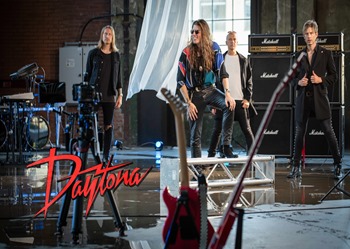
MM : Your guitar brings each song to life, with captivating backing parts and catchy, memorable solos that leave a strong impression. What are your thoughts on your guitar style?
EH : Thank you so much for the nice compliment! I really focused on the overall feel when I played and arranged the guitars for this album. I’m heavily influenced by Dann Huff’s approach to arranging guitars. When I wrote the solos for the album, I tried to pick up on certain melodies from the song and build the solo around them, rather than just shredding. Of course, I love Yngwie Malmsteen, but for Daytona, a more restrained style of playing was needed. I think Kee Marcello is a master at playing melodic solos, and that was also a big inspiration.
MM : Many rock guitarists tend to play in a way that puts them front and center, but you focus on serving the song, which is commendable. Could you share your thoughts on this approach?
EH : Yes, exactly! I was thinking about that earlier, and I’m glad you perceived my playing that way. I’ve never been particularly good at shredding anyway! I always prioritize the song and the melody. You know, I think 95% of listeners focus on the vocals first, so they need to be prominent and clear in the mix. All instruments should be easily heard; if you want to hear what the bassist is playing, you should be able to do so. There must be space and dynamics. I think far too many people are mastering their albums too loudly these days, which loses the dynamics. I get bored pretty quickly if it’s just full throttle all the time!
Regarding guitar playing, I believe every note counts, so I’d rather focus on a variety of elements than just the number of notes per second—things like variation, tone, and vibrato, etc.
MM : In the middle section of Slave To The Rhythm, you’ve chosen to feature a saxophone solo instead of a guitar solo. Could you tell us about that decision?
FW : Had to be a sax-solo on at least one tune. It’s like mandatory when doing this genre, isn’t it? Saxophone is also a very expressive instrument and it suits rock music very well when played with a lot of soul. It goes all the way back to the 50’s rock n roll roots.
MM : Could you tell us about the guitars, amps, and pedals you used on the album?
EH : I’ve played a variety of guitars on this album. While my go-to is the Stratocaster, I began with humbucker guitars for the rhythm sections. I’ve used models from Kramer, Jackson, G&L and Ibanez Les Paul Jr. equipped with an amazing DiMarzio pickup. This Ibanez is actually the first guitar my dad gave me when I was about 10 years old. I then immersed myself in crafting sounds that drew inspiration from Dann Huff’s tone on the first two GIANT albums. A friend in England assisted me in finding an effective combination of effects, which included the Yamaha SPX90, Eventide H90, DBX160A, and Daytronics CX5, among others.
MM : Finally, could you share a message for the music fans who will be discovering you through this album?
EH : Even though we all in Daytona have quite a bit of experience from other bands, I am humble in knowing that this is completely new, a debut band. And I must say that I am surprised and humbly happy about the enormously positive reception and interest we have received so far. But I believe it is because it shows that we do this out of pure love for the music and that we have a clear vision of how we want to sound and how it should look— the whole package. It is not based on nostalgia but is purely based on the fact that it is precisely that era of hard rock that we love the most!
FW : I sincerely hope you’ll enjoy our new album from Daytona, Garder La Flamme. I must say it’s been far too long since I last went to Japan, and I hope to be back in the foreseeable future. 日本が恋しいです (Nihon ga koishii desu) — I miss you!
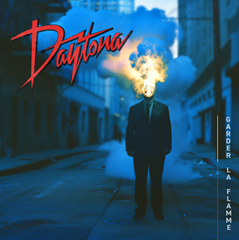
Daytona / Garder La Flamme
1. Welcome To The Real World
2. Kelly
3. Through The Storm
4. Downtown
5. Time Won’t Wait
6. Looks Like Rain
7. Town Of Many Faces
8. Slave To The Rhythm
9. Garder La Flamme
10. Where Did We Lose The Love
Lineup
Fredrik Werner – Vocals (Osukaru and Air Raid)
Erik Heikne – Guitars (Miss Behaviour)
Johan Berlin – Keyboards (ex.Eclipse)
Niclas Lindblom – Bass guitar
Calle Larsson – Drums
